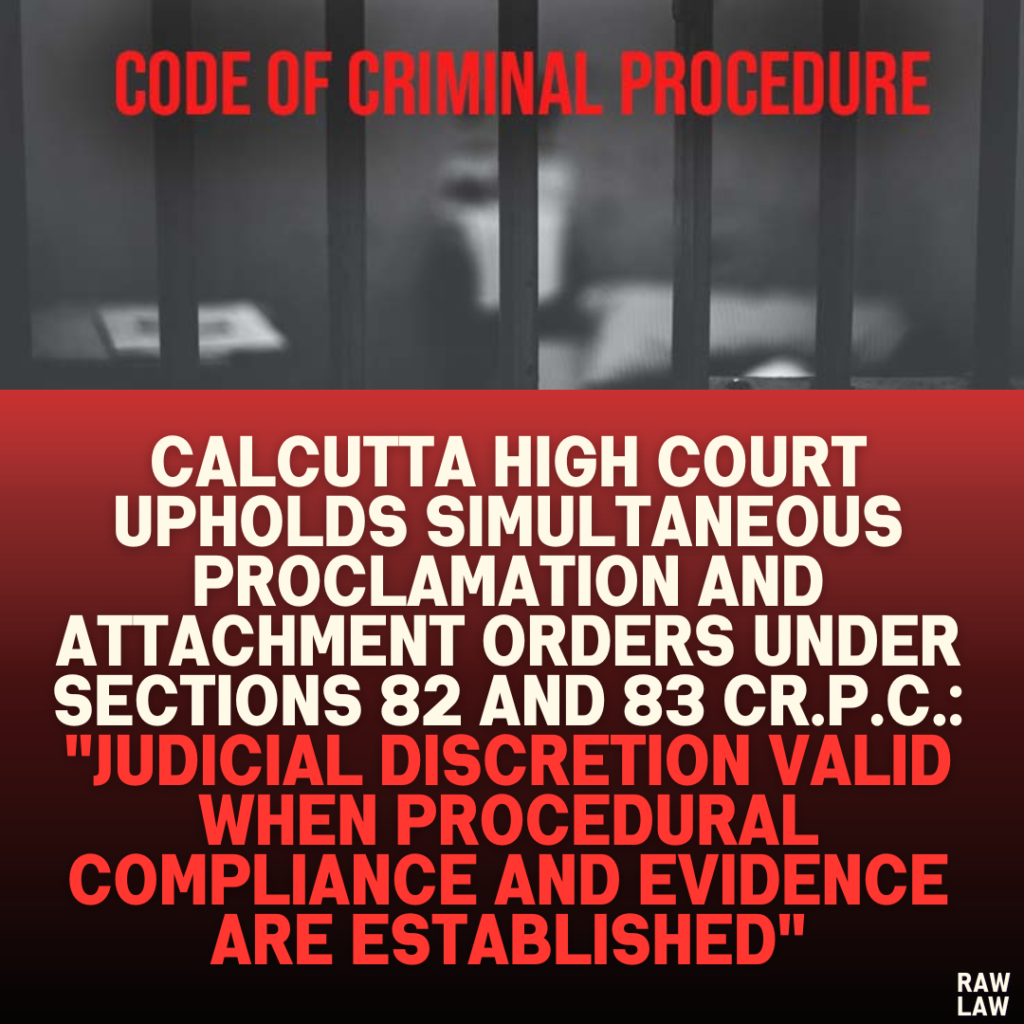1. Court’s Decision:
The Calcutta High Court dismissed the revisional application filed by the petitioner. It upheld the trial court’s simultaneous issuance of orders for proclamation and attachment of property under Sections 82 and 83 of the Cr.P.C. The High Court found that these orders complied with the procedural and substantive requirements laid down under the law and required no interference.
2. Facts:
- Background:
The case involved criminal proceedings arising from an incident registered under Sections 307 (attempt to murder), 326 (causing grievous hurt by dangerous weapons), and 34 (acts done by several persons in furtherance of common intention) of the Indian Penal Code (IPC) at Narkeldanga Police Station.
The case was registered as G.R. Case No. 2095 of 2021 and was later numbered as SC 3 (04) of 2022 before the learned Additional Sessions Judge, 1st Court, South 24-Parganas. - Challenged Orders:
The petitioner challenged two orders issued by the trial court:- Order dated 04.10.2021: This order pertained to the issuance of a proclamation for the petitioner as an absconding accused.
- Order dated 11.11.2021: This order involved the issuance of an attachment of the petitioner’s property.
- The petitioner argued that these orders were issued improperly and without adherence to the procedural safeguards required under the Cr.P.C.
3. Issues:
- Compliance with Sections 82 and 83 Cr.P.C.:
Whether the trial court’s simultaneous issuance of proclamation and attachment orders was lawful and adhered to procedural requirements. - Judicial Oversight:
Whether the orders issued by the trial court warranted interference by the revisional court.
4. Petitioner’s Arguments:
The petitioner raised the following points:
- The trial court failed to justify the simultaneous issuance of proclamation and attachment orders, as required under Section 83(1) Cr.P.C.
- The procedural prerequisites, including proper inquiry and sufficient reasons to declare the petitioner absconding, were allegedly not fulfilled.
- The orders lacked detailed reasoning and were issued in a mechanical manner.
5. Respondent’s Arguments:
The State made the following submissions:
- The orders were issued strictly in compliance with Sections 82 and 83 Cr.P.C.
- The petitioner was absconding and concealing himself to evade the execution of warrants, necessitating the issuance of proclamation and attachment orders.
- All procedural formalities were observed, and sufficient material existed on record to justify the trial court’s decision.
6. Analysis of the Law:
Section 82 Cr.P.C. – Proclamation for a Person Absconding
- This section allows a court to issue a proclamation against a person who has absconded or is concealing themselves to avoid execution of a warrant.
- Key procedural requirements:
- A written proclamation specifying the time and place for appearance.
- A minimum of 30 days’ notice from the date of proclamation.
- Publication of the proclamation in a conspicuous location, such as the accused’s residence, the locality, or through newspapers.
Section 83 Cr.P.C. – Attachment of Property
- This section provides for the attachment of property of an absconding person under a proclamation issued under Section 82.
- Key provisions:
- Simultaneous attachment with proclamation is permitted if the court is satisfied that the accused is likely to dispose of or remove their property from the court’s jurisdiction.
- The order must include reasons for such action, recorded in writing.
Application of the Law:
- The court found that the trial court had adhered to these requirements.
- Simultaneous issuance: Section 83(1) Cr.P.C. explicitly permits simultaneous issuance of proclamation and attachment if justified by circumstances.
- Reasoned orders: The trial court recorded its reasons for believing that the petitioner was absconding and likely to dispose of his property.
7. Precedent Analysis:
The petitioner relied on several precedents to challenge the legality of the orders:
- Babun Midder v. State of West Bengal (2021 SCC Online Cal 338):
Emphasized procedural compliance under Sections 82 and 83 Cr.P.C. and the necessity for courts to record reasons for declaring someone a proclaimed offender. - Nanki Bhayna @ Ratan Bhayna v. State of West Bengal:
Highlighted that an order for proclamation must not be issued mechanically and must be based on specific evidence. - Sambhu Halder v. The State of West Bengal (2014 SCC Online Cal 4268):
Clarified the role of judicial discretion in issuing proclamation and attachment orders. - Rohit Kumar Sah v. State of West Bengal (2021 SCC Online Cal 1665):
Discussed evidentiary thresholds for issuing proclamation and attachment orders.
The court applied these judgments and found that the trial court’s orders met the standards set in these precedents.
8. Court’s Reasoning:
- Procedural Compliance:
The High Court observed that the trial court followed the procedures mandated under Sections 82 and 83 Cr.P.C. The orders were based on valid reasons and sufficient evidence. - Judicial Discretion:
The simultaneous issuance of proclamation and attachment was justified as the petitioner was likely to dispose of his property. This action was within the discretion of the trial court under Section 83(1) Cr.P.C. - No Grounds for Interference:
The revisional court’s scope of review is limited to procedural irregularities or errors in law. Since no such errors were identified, the High Court upheld the orders.
9. Conclusion:
- The High Court dismissed the revisional application and affirmed the trial court’s orders.
- It directed that the judgment be sent to the trial court for compliance.
- All interim applications were disposed of.
10. Implications:
- The judgment reinforces the procedural safeguards under Sections 82 and 83 Cr.P.C.
- It establishes a clear precedent for the simultaneous issuance of proclamation and attachment orders when justified by circumstances.
- It underscores the importance of judicial discretion and adherence to procedural requirements.
